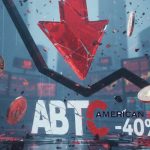Bitcoin has officially entered unprecedented territory, surging past $125,000 this week to set a new All-Time High (ATH). For US advance traders, this is not just a price point; it’s a signal of extreme market stress and the maturation of regulated access points. The recent parabolic move has been fueled by a toxic mix of macro instability—specifically, the U.S. government shutdown—and accelerating institutional adoption vehicles. Understanding these dual catalysts and the specialized derivatives available to American investors is crucial for capitalizing on the current volatility.
The US Government Shutdown: BTC’s Unconventional Catalyst
The dramatic price action, which saw Bitcoin “go through the roof,” coincided directly with the ongoing U.S. government shutdown. This linkage is a powerful indicator of Bitcoin’s evolving role as a true decentralized hedge against systemic risk within the world’s largest economy.
When the US financial regulatory system stalls and traditional markets face uncertainty, institutional capital and sophisticated retail traders are forced to seek assets that operate “in the dark”—outside of conventional oversight.
Market Dynamics: Flight to Quality vs. Decentralization
For the advanced trader, the narrative shifts from simple “digital gold” to “operational resilience.”
- The shutdown paralyzes key regulatory bodies and data releases, forcing investors to trade on limited information.
- Bitcoin, by design, remains operational and transparent, offering an executable market with 24/7 liquidity and immutable ledgers, making it a reliable destination during a domestic governance crisis.
- The psychological impact of forced trading in decentralized assets drives fear-based premium, pushing the $125,000 valuation far sooner than many fundamental models predicted. This necessitates swift re-evaluation of risk-adjusted returns on BTC exposure.
Beyond the Wallet: Advanced US Investment Vehicles for $125k BTC
While direct cryptocurrency purchase remains an option, sophisticated US traders often prioritize tax efficiency and regulatory clarity. The recent surge highlights the critical role of regulated, indirect investment vehicles, allowing institutional and high-net-worth individuals to gain exposure without the custody risk or the complex reporting associated with owning the underlying asset.
The best way to invest in Bitcoin without actually buying the cryptocurrency involves leveraging US-listed derivatives and exchange-traded products:
| Vehicle | Use Case for Advanced Traders | Regulatory Clarity |
| Spot Bitcoin ETFs | Long-term core exposure, bypassing custody/security challenges. Highly liquid and tradable in standard brokerage accounts. | High (SEC-regulated product structure) |
| Bitcoin Futures ETFs | Hedging existing spot exposure, short-term directional bets, and contango/backwardation arbitrage strategies. | Highest (Regulated by the CFTC) |
| Bitcoin Micro Futures | High-leverage, small-unit speculation for risk management and granular position sizing in volatile markets. | High (Regulated by the CFTC) |
| Publicly Traded BTC Miners/Holders | Equities correlation play; sector-specific hedging against operational risk or specific tax strategies (e.g., wash sale rule avoidance). | High (SEC-regulated stock) |
Key Tactic: Basis Trade: Advanced traders are currently exploiting the difference (or “basis”) between the regulated Bitcoin futures market (e.g., CME) and the surging spot price. By simultaneously buying the spot equivalent (via a highly correlated Spot ETF) and selling a further-dated futures contract, traders can lock in arbitrage profit, a classic strategy that thrives during periods of extreme volatility like the move past $125k.
Navigating the Regulatory Landscape: Compliance and Capital Gains
For US-based traders, the $125,000 ATH means two things: amplified profits and complex tax reporting.
- Capital Gains Tax: All gains are subject to IRS capital gains rules. The distinction between short-term (held for one year or less, taxed at ordinary income rates) and long-term (held for more than one year, lower preferential rates) is paramount to net returns.
- Wash Sale Risk: While the IRS has clarified that crypto-to-crypto trades may not be subject to the wash sale rule, the increasing use of regulated ETFs and derivative products brings these transactions squarely under existing US securities tax law. Traders must meticulously track disposition dates when realizing losses on regulated vehicles to avoid disallowed deductions.
The surge to $125,000 is a clear call for advanced US investors to move beyond simple long exposure. It demands a sophisticated approach that integrates regulated access points, derivatives-based hedging, and proactive tax planning to secure profits in a market defined by both governmental instability and unprecedented growth.
FAQ
Yes, from a compliance and custody perspective. For US advance traders, safety is less about blockchain security and more about regulatory assurance. A Spot Bitcoin ETF (or futures ETF) shifts the regulatory and custody burdens from the individual investor to the regulated, audited ETF provider. This simplifies reporting, eliminates the risk of private key loss, and ensures transactions occur within established brokerage frameworks, providing a superior solution for institutional or large-scale retail capital that prioritizes compliance and operational security over direct asset control.
No, your ability to trade remains largely operational. The CME Group (where regulated Bitcoin futures and micro futures trade) operates independently of non-essential government services. While the visibility and response time of the CFTC (Commodity Futures Trading Commission) might be temporarily impacted, the core trading infrastructure and settlement systems continue to function. The liquidity and execution pathways for hedging and speculation remain robust, proving the resilience of these regulated vehicles during domestic governance crises.
Since $125,000 is a new ATH, traditional historical resistance is unavailable. Advanced traders should focus on psychological round numbers and Fibonacci extension levels. The immediate psychological targets are $150,000 and the major threshold of $200,000. Beyond these, volume profile analysis and market structure indicators (e.g., funding rates, open interest) will be more instructive than conventional technical analysis. Expect these round figures to attract significant profit-taking and fresh short interest.
The most significant advantage for active US traders is the potential application of the 60/40 rule under Section 1256 of the IRS code (which covers regulated futures contracts). This rule mandates that all net gains (and losses) are taxed as 60% long-term capital gains and 40% short-term capital gains, regardless of the actual holding period. This blended rate can be substantially lower than the ordinary income tax rates applied to short-term spot crypto gains, offering a critical edge for sophisticated, high-frequency derivative traders.
Extreme caution is advised. While the $125k surge presents massive profit potential, the catalyst (a US shutdown) is a high-volatility macro event that can reverse sharply upon resolution. Advanced traders should use leverage primarily for targeted hedging and basis trade execution, not for excessive directional gambling. Utilize Bitcoin Micro Futures for granular, low-capitalized position sizing, allowing tight risk management through defined stop-losses and measured exposure increases. Never trade with leverage that could result in liquidation during an expected flash-crash associated with a political resolution.






